VARIETY AND I
Page 43
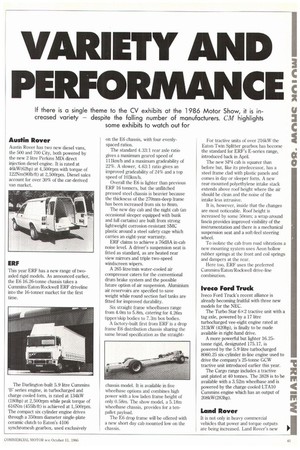
Page 44
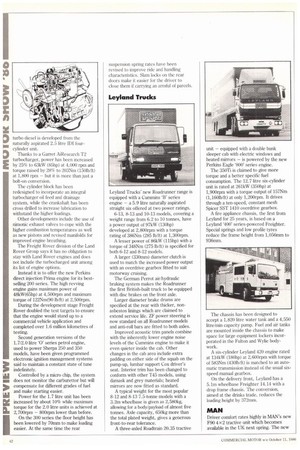
Page 48
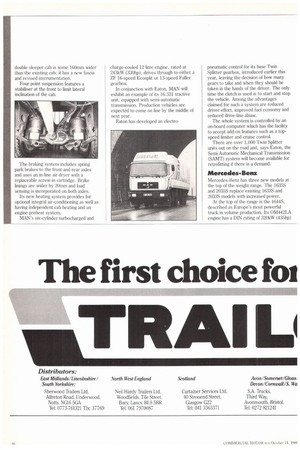
Page 49
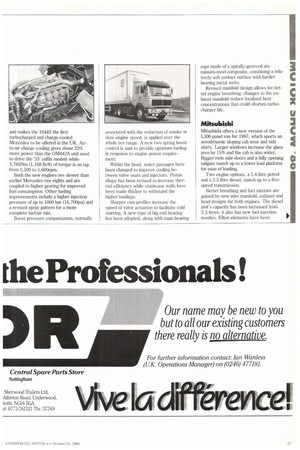
Page 50
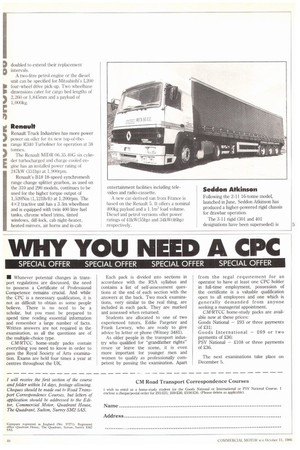
Page 53
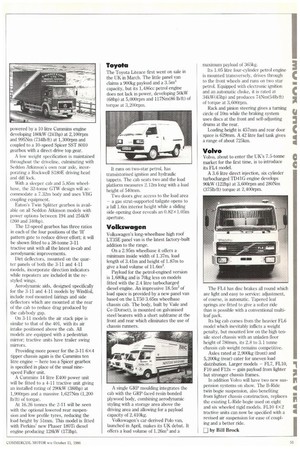
If you've noticed an error in this article please click here to report it so we can fix it.
PERFORMANCE
If there is a single theme to the CV exhibits at the 1986 Motor Show, it is increased variety — despite the falling number of manufacturers. CM highlights some exhibits to watch out for
Austin Rover
Austin Rover has two new diesel vans, the 500 and 700 City, both powered by the new 2 litre Perkins MIN direct injection diesel engine. It is rated at 46kW(62hp) at 4,500rpm with torque of 122Nm(90Ib/ft) at 2,500rpm. Diesel sales account for over 30% of the car-derived van market.
ERF
This year ERF has a new range of twoaxled rigid models. As announced earlier, the E6 16.26-tonne chassis takes a Cummins/Eaton/Rockwell ERF driveline into the 16-tonner market for the first time.
The Darlington-built 5.9 litre Cummins 'B' series engine, in turbocharged and charge cooled form, is rated at 134kW (180hp) at 2,500rpm while peak torque of 616Nm (4551b/ft) is achieved at 1,500rpm. The compact six cylinder engine drives through a 350mm diameter single-plate ceramic clutch to Eaton's 4106 synchromesh gearbox, used exclusively on the E6 chassis, with four evenlyspaced ratios.
The standard 4.33:1 rear axle ratio gives a maximum geared speed of 111km/h and a maximum gradeability of 22%. A slower, 4.63:1 ratio gives an improved gradeability of 24% and a top speed of 103km/h.
Overall the E6 is lighter than previous ERF 16 tonners, but the unflitched pressed steel chassis is heavier because the thickness of the 270mm-deep frame has been increased from six to 8mm.
The new day cab and the night cab (an occasional sleeper equipped with bunk and full curtains) are built from strong lightweight corrosion-resistant SMC plastic around a steel safety cage which carries an eight-year warranty.
ERF claims to achieve a 76dBA in-cab noise level. A driver's suspension seat is fitted as standard, as are heated rear view mirrors and triple two-speed windscreen wipers.
A 265 litre/min water-cooled air compressor caters for the conventional drum brake system and the possible future option of air suspension. Aluminium air reservoirs are specified to save weight while round section fuel tanks are fitted for improved durability.
Six straight frame wheelbases range from 4.0m to 5.8m, catering for 4.26m tipper/skip bodies to 7.3m box bodies.
A factory-built first from ERF is a drop frame E6 distribution chassis sharing the same broad specification as the straight chassis model. It is available in five wheelbase options and combines high power with a low laden frame height of only 0.58m. The show model, a 5.18m wheelbase chassis, provides for a tenpallet payload.
The E6 drop frame will be offered with a new short day cab mounted low on the chassis. For tractive units of over 216kW the Eaton Twin Splitter gearbox has become the standard for ERF's E-series range, introduced back in April.
The new SP4 cab is squarer than before but, like its predecessor, has a steel frame clad with plastic panels and comes in day or sleeper form. A new rear-mounted polyethylene intake stack extends above roof height where the air should be clean and the noise of the intake less intrusive.
It is, however, inside that the changes are most noticeable. Roof height is increased by some 50mm; a wrap-around fascia provides improved visibility of the instrumentation and there is a mechanical suspension seat and a soft-feel steering wheel.
To isolate the cab from road vibrations a new mounting system uses Aeon hollow rubber springs at the front and coil springs and dampers at the rear.
Here too, ERF uses the preferred Cummins/Eaton/Rockwell drive-line combination.
iVOCO Ford Truck
Iveco Ford Truck's recent alliance is already becoming fruitful with three new models for the NEC.
The Turbo Star 6 x2 tractive unit with a tag axle, powered by a 17 litre turbocharged vee-eight engine rated at 313kW (420hp), is finally to be made available in right-hand drive.
A more powerful but lighter 16.25tonne rigid, designated 175.17, is powered by the 5.9 litre turbocharged 8060.25 six-cylinder in-line engine used to drive the company's 25-tonne GCW tractive unit introduced earlier this year.
The Cargo range includes a tractive unit plated at 40 tonnes. The 3828 is to be available with a 3.52m wheelbase and is powered by the charge cooled LTA10 Cummins engine which has an output of 208kW(283hp).
Land Rover
It is not only in heavy commercial vehicles that power and torque outputs are being increased. Land Rover's new turbo diesel is developed from the naturally aspirated 2.5 litre 101 fourcylinder unit.
Thanks to a Garret AiResearch T2 turbocharger, power has been increased by 25% to 63kW (85hp) at 4,000 rpm and torque raised by 28% to 203Nm (1501b/ft) at 1,800 rpm — but it is more than just a bolt-on conversion.
The cylinder block has been redesigned to incorporate an integral turbocharger oil feed and drainage system, while the crankshaft has been cross drilled to increase lubrication to withstand the higher loadings.
Other developments include the use of nimonic exhaust valves to cope with the higher combustion temperatures as well as new pistons and revised manifolds for improved engine breathing.
The Freight Rover division of the Land Rover Group says it has no obligation to stay with Land Rover engines and does not include the turbocharged unit among its list of engine options.
Instead it is to offer the new Perkins direct injection Prima engine for its bestselling 200 series. The high revving engine gains maximum power of 48kW(65hp) at 4,500rpm and maximum torque of 122Nm(90 lb/ft) at 2,500rpm.
During the development stage Freight Rover doubled the test targets to ensure that the engine would stand up to a commercial vehicle application and completed over 1.6 million kilometres of testing.
Second generation versions of the 1.7/2.0 litre '0' series petrol engine, used to power Sherpa 250 and 350 models, have been given programmed electronic ignition management systems said to maintain a constant state of tune indefinitely.
Controlled by a micro chip, the system does not monitor the carburettor but will compensate for different grades of fuel and make starting easier.
Power for the 1.7 litre unit has been increased by about 10% while maximum torque for the 2.0 litre units is achieved at 2,700rpm — 800rpm lower than before.
On the 300 series the floor height has been lowered by 70mm to make loading easier. At the same time the rear suspension spring rates have been revised to improve ride and handling characteristics. Slam locks on the rear doors make it easier for the driver to close them if carrying an armful of parcels.
Leyland Trucks
Leyland Trucks' new Roadrunner range is equipped with a Ciunmins 'B' series engine — a 5.9 litre naturally aspirated straight six offered at two power ratings.
6-13, 8-13 and 10-13 models, covering a weight range from 6.2 to 10 tonnes, have a power output of 97kW (130hp) developed at 2,800rpm with a torque rating of 386Nm (285 lb/ft) at 1,300rpm.
A lesser power of 86kW (115hp) with a torque of 348Nm (275 lb/ft) is specified for both 6-12 and 8-12 models.
A larger (330min) diameter clutch is used to match the increased power output with an overdrive gearbox fitted to suit motorway cruising.
The German Perrot air/hydraulic braking system makes the Roadrunner the first British-built truck to be equipped with disc brakes on the front axle.
Larger diameter brake drums are specified at the rear with thicker, nonasbestos linings which are claimed to extend service life. ZF power steering is now standard on all Roadrunner models and anti-roll bars are fitted to both axles.
Improved acoustic trim panels combine with the inherently lower engine noise levels of the Cummins engine to make it even quieter inside the cab. Other changes in the cab area include extra padding on either side of the squab on the pump-up, lumbar support Cox driver's seat. Interior trim has been changed to conform with other T45 models, using damask and grey materials; heated mirrors are now fitted as standard.
A typical weight for the most popular 8-12 and 8-13 7.5-tonne models with a 3.2m wheelbase is given as 2,580kg, allowing for a body/payload of almost five tonnes. Axle capacity, 650kg more than the total plated weight, gives a generous front-to-rear tolerance.
A three-aided Roadtrain 20.35 tractive unit — equipped with a double bunk sleeper cab with electric windows and heated mirrors — is powered by the new Perkins Eagle '800' series engine.
The 350Ti is claimed to give more torque and a better specific fuel consumption. The 12.7 litre six-cylinder unit is rated at 261kW (350hp) at 1,900rpm with a torque output of 157Nm (1,160lb/ft) at only 1,200rpm. It drives through a ten-speed, constant mesh Spicer SST 1410 overdrive gearbox.
A fire appliance chassis, the first from Leyland for 25 years, is based on a Leyland '400' series-powered Freighter. Special springs and low profile tyres reduce the frame height from 1,056mm to 936mm.
The chassis has been designed to accept a 1,820 litre water tank and a 4,550 litre/min capacity pump. Fuel and air tanks are mounted inside the chassis to make space for large equipment lockers incorporated in the Fulton and Wylie bodywork.
A six-cylinder Leyland 420 engine rated at 134kW (180hp) at 2,600rpm with torque of 583Nm (430lb/ft) is matched to an automatic transmission instead of the usual sixspeed manual gearbox.
On the delivery front, Leyland has a 5.1m wheelbase Freighter 14.14 with a drop frame chassis. The conversion, aimed at the drinks trade, reduces the loading height by 372mm.
MAN
Driver comfort rates highly in MAN's new F90 4x2 tractive unit which becomes available in the UK next spring. The new double sleeper cab is some 160mm wider than the existing cab; it has a new fascia and revised instrumentation.
Four point suspension features a stabiliser at the front to limit lateral inclination of the cab.
The braking system includes spring park brakes to the front and rear axles and uses an in-line air dryer with a replaceable screw7in cartridge. Brake linings are wider by 20mm and load sensing is incorporated on both axles.
Its new heating system provides for optional integral air-conditioning as well as having independent cab heating and an engine preheat system.
MAN's six-cylinder turbocharged and charge-cooled 12 litre engine, rated at 243kW (330hp), drives through to either a ZF 16-speed Ecosplit or 13-speed Fuller gearbox.
In conjunction with Eaton, MAN will exhibit an example of its 16.331 tractive unit, equipped with semi-automatic transmission. Production vehicles are expected to come on line by the middle of next year.
Eaton has developed an electro
pneumatic control for its base Twin Splitter gearbox, introduced earlier this year, leaving the decision of how many gears to take and when they should be taken in the hands of the driver. The only time the clutch is used is to start and stop the vehicle. Among the advantages claimed for such a system are reduced driver effort, improved fuel economy and reduced drive-line abuse.
The whole system is controlled by an on-board computer which has the facility to accept add-on features such as a topspeed limiter and cruise control.
There are over 1,000 Twin Splitter units out on the road and, says Eaton, the Semi Automatic Mechanical Transmission (SAMT) system will become available for retrofitting if there is a demand.
Mercedes-Benz
Mercedes-Benz has three new models at the top of the weight range. The 1635S and 2035S replace existing 1633S and 2033S models with increased power.
At the top of the range is the 1644S, described as Europe's most powerful truck in volume production. Its 0M442LA engine has a DIN rating of 320kW (435hp) and makes the 1644S the first turbocharged and charge-cooled Mercedes to be offered in the UK. Airto-air charge cooling gives about 23% more power than the 0M442A unit used to drive the '35' suffix models while 1,765Nm (1,168 lb/ft) of torque is on tap from 1,100 to 1,600rpm.
Both the new engines rev slower than earlier Mercedes vee eights and are coupled to higher gearing for improved fuel consumption. Other fueling improvements include a higher injection pressure of up to 1000 bar (14,700psi) and a revised spray pattern for a more complete fueUair mix.
Boost pressure compensation, normally associated with the reduction of smoke at slow engine speed, is applied over the whole rev range. A new two spring boost control is said to provide optimum fueling in response to engine power requirement.
Within the head, water passages have been changed to improve cooling between valve seats and injectors. Piston shape has been revised to increase thermal efficiency while crankcase walls have been made thicker to withstand the higher loadings.
Sharper cam profiles increase the speed of valve actuation to facilitate cold starting. A new type of big end bearing has been adopted, along with main bearing caps made of a spirally-grooved aluminium-steel composite, combining a relatively soft contact surface with harder bearing metal webs.
Revised manifold design allows for better engine breathing; changes to the exhaust manifold reduce localised heat concentrations that could shorten turbocharger life.
Mitsubishi
Mitsubishi offers a new version of the L300 panel van for 1987, which sports all aerodynamic sloping cab nose and side skirts. Larger windows increase the glass area by 15% and the cab is also wider. Bigger twin side-doors and a fully opening tailgate match up to a lower load platform for ease of loading.
Two engine options, a 1.6 litre petrol and a 2.5 litre diesel, match up to a fivespeed transmission.
Better breathing and fuel mixture are gained by new inlet manifold, exhaust and head designs for both engines. The diesel unit's capacity has been increased from 2.3 litres; it also has new fuel injection nozzles. Filter elements have been doubled to extend their replacement intervals.
A two-litre petrol engine or the diesel unit can be specified for Mitsubishi's L200 four-wheel drive pick-up. Two wheelbase dimensions cater for cargo bed lengths of 2,260 or 1,845mm and a payload of 1,000kg.
Renault
)Renault Truck Industries has more power power on offer for its new top-of-the
• range R340 Turboliner for operation at 38 tonnes. The Renault MIDR 06.35.40G six Min E der turbocharged and charge cooled en • gine has an installed power rating of 247kW (331hp) at 1,900rprn.
Renault's 818 18-speed synchromesh range change splitter gearbox, as used on the 310 and 290 models, continues to be used for the higher torque output of 1,520Nm (1,121lb/ft) at 1,200rpm. The 4 X 2 tractive unit has a 3.3m wheelbase and is equipped with twin 400 litre fuel tanks, chrome wheel trims, tinted windows, diff-lock, cab night-heater, heated mirrors, air horns and in-cab entertainment facilities including televideo and radio-cassette.
A new car-derived van from France is based on the Renault 5. It. offers a nominal 400kg payload and a 1.1m3 load volume. Diesel and petrol versions offer power ratings of 41kW(55hp) and 34kW(46hp) respectively.
Seddon Atkinson
Following the 2-11 16-tonne model, launched in June, Seddon Atkinson has produced a higher-powered rigid chassis for drawbar operation.
The 3-11 rigid (301 and 401 designations have been superseded) is powered by a 10 litre Cummins engine developing 180kW (241hp) at 2,100rpm and 995Nm (7341b/ft) at 1,300rpm and coupled to a 10-speed Spicer SST 8010 gearbox with a direct-drive top gear.
A low weight specification is maintained throughout the driveline, culminating with Seddon Atkinson's own rear axle, incorporating a Rockwell S180E driving head and diff lock.
With a sleeper cab and 5.85m wheelbase, the 32-tonne GTW design will accommodate a 7,32m body and uses VBG coupling equipment.
Eaton's Twin Splitter gearbox is available on all Seddon Atkinson models with power options between 194 and 254kW (260 and 340hp).
The 12-speed gearbox has three ratios in each of the four positions of the 'H' pattern gate to reduce driver effort; it will be shown fitted to a 38-tonne 3-11 tractive unit with all the latest in-cab and aerodynamic improvements.
Dirt deflectors, mounted on the quarter panels of both the 3-11 and 4-11 models, incorporate direction indicators while repeaters are included in the restyled wings.
Aerodynamic aids, designed specifically for the 3-11 and 4-11 models by Windfoil, include roof-mounted fairings and side deflectors which are mounted at the rear of the cab to reduce drag produced by the cab/body gap.
On 3-11 models the air stack pipe is similar to that of the 401, with its air intake positioned above the cab. All models are equipped with a pedestrian mirror; tractive units have trailer swing mirrors.
Providing more power for the 3-11 6x4 tipper chassis again is the Cummins ten litre engine — here too a Spicer gearbox is specified in place of the usual ninespeed Fuller unit.
A Cummins 14 litre E400 power unit will be fitted to a 4-11 tractive unit giving an installed rating of 290kW (388hp) at 1,900rprn and a massive 1,627Nm (1,200 lb/ft) of torque.
At 16.26 tonnes the 2-11 will be seen with the optional lowered rear suspension and low profile tyres, reducing the load height by 51mm. This model is fitted with Perkins' new Phaser 180Ti diesel engine producing 128kW (173hp).
Toyota
The Toyota Liteace first went on sale in the UK in March. The little panel van claims a 900kg payload and a 3.5m3 capacity, but its 1,486cc petrol engine does not lack in power, developing 50kW (68hp) at 5,000rprn and 117Nm(86 lb/ft) of torque at 3,200rpm.
It runs on two-star petrol, has transistorised ignition and hydraulic tappets. The cab seats two and the load platform measures 2.12m long with a load height of 540mm.
Two doors give access to the load area — a gas strut-supported tailgate opens to a full 1.6m interior height while a sliding side opening door reveals an O. 82x 1.05m aperture.
Volkswagen
Volkswagen's long-wheelbase high roof LT35E panel van is the latest factory-built addition to the range.
On a 2.95m wheelbase it offers a minimum inside width of 1.37m, load length of 3.41m and height of 1.87m to give a load volume of 11.6m3.
Payload for the petrol-engined version is 1,680kg and is 70kg less on models fitted with the 2.4 litre turbocharged diesel engine. An impressive 18.5m3 of load space is provided by a new panel van based on the LT50 3.65m wheelbase chassis cab. The body, built by Vaile and Co (Dorset), is mounted on galvanised steel bearers with a short subframe at the front and rear which eliminates the use of chassis runners.
A single GRP moulding integrates the cab with the GRP-faced resin-bonded plywood body, combining aerodynamic styling with a storage area above the driving area and allowing for a payload capacity of 2,410kg.
Volkswagen's car-derived Polo van, Launched in April, makes its UK debut. It offers a load volume of 1.26m3 and a
maximum payload of 365lig.
Its 1.05 litre four-cylinder petrol engine is mounted transversely, drives through to the front wheels and runs on two star petrol. Equipped with electronic ignition and an automatic choke, it is rated at 34kW(45hp) and produces 74Nm(541b/ft) of torque at 3,600rpm.
Rack and pinion steering gives a turning circle of 10m while the braking system uses discs at the front and self-adjusting drums at the rear.
Loading height is 457mm and rear door space is 629mm. A 42 litre fuel tank gives a range of about 725km.
Volvo
Volvo, about to enter the UK's 7.5-tonne market for the first time, is to introduce its FL4 model.
A 3.6 litre direct injection, six cylinder turbocharged TD41G engine develops 90kW (122hp) at 3,600rpm and 280Nm (3751b/ft) torque at 2,400rpm.
The FL4 has disc brakes all round which are light and easy to service; adjustment, of course, is automatic. Tapered leaf springs are fitted to give a softer ride than is possible with a conventional multileaf pack.
Its big cab comes from the heavier FL6 model which inevitably inflicts a weight penalty, but mounted low on the high tensile steel chassis with an unladen floor height of 780mm, its 2.8 to 3.1 tonne chassis cab weight remains competitive.
Axles rated at 2,900kg (front) and 5,200kg (rear) cater for uneven load distribution. Larger models — FL?, FL10, F10 and F12s — gain payload from lighter but stronger chassis frames.
In addition Volvo will have two new suspension systems on show. The B-Ride twin bogie suspension, also benefiting from lighter chassis construction, replaces the existing L-Ride bogie used on eight and six wheeled rigid models. FL10 4 x 2 tractive units can now be specified with a revised air suspension for ease of coupling and a better ride.
El by Bill Brock
























































































































